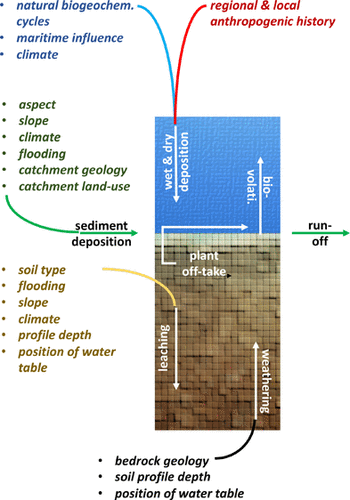当前位置:
X-MOL 学术
›
Environ. Sci. Technol.
›
论文详情
Our official English website, www.x-mol.net, welcomes your
feedback! (Note: you will need to create a separate account there.)
The Pedosphere as a Sink, Source, and Record of Anthropogenic and Natural Arsenic Atmospheric Deposition
Environmental Science & Technology ( IF 10.8 ) Pub Date : 2021-05-28 , DOI: 10.1021/acs.est.1c00460 Andrew A Meharg 1 , Caroline Meharg 1
Environmental Science & Technology ( IF 10.8 ) Pub Date : 2021-05-28 , DOI: 10.1021/acs.est.1c00460 Andrew A Meharg 1 , Caroline Meharg 1
Affiliation

|
The Anthropocene has led to global-scale contamination of the biosphere through diffuse atmospheric dispersal of arsenic. This review considers the sources arsenic to soils and its subsequent fate, identifying key knowledge gaps. There is a particular focus on soil classification and stratigraphy, as this is central to the topic under consideration. For Europe and North America, peat core chrono-sequences record massive enhancement of arsenic depositional flux from the onset of the Industrial Revolution to the late 20th century, while modern mitigation efforts have led to a sharp decline in emissions. Recent arsenic wet and dry depositional flux measurements and modern ice core records suggest that it is South America and East Asia that are now primary global-scale polluters. Natural sources of arsenic to the atmosphere are primarily from volcanic emissions, aeolian soil dust entrainment, and microbial biomethylation. However, quantifying these natural inputs to the atmosphere, and subsequent redeposition to soils, is only starting to become better defined. The pedosphere acts as both a sink and source of deposited arsenic. Soil is highly heterogeneous in the natural arsenic already present, in the chemical and biological regulation of its mobility within soil horizons, and in interaction with climatic and geomorphological settings. Mineral soils tend to be an arsenic sink, while organic soils act as both a sink and a source. It is identified here that peatlands hold a considerable amount of Anthropocene released arsenic, and that this store can be potentially remobilized under climate change scenarios. Also, increased ambient temperature seems to cause enhanced arsine release from soils, and potentially also from the oceans, leading to enhanced rates of arsenic biogeochemical cycling through the atmosphere. With respect to agriculture, rice cultivation was identified as a particular concern in Southeast Asia due to the current high arsenic deposition rates to soil, the efficiency of arsenic assimilation by rice grain, and grain yield reduction through toxicity.
中文翻译:

作为人为和自然砷大气沉积的汇、来源和记录的土壤圈
人类世通过砷在大气中的扩散扩散导致了全球范围的生物圈污染。本综述考虑了土壤中砷的来源及其随后的命运,确定了关键的知识差距。特别关注土壤分类和地层学,因为这是正在考虑的主题的核心。对于欧洲和北美,泥炭核心年代序列记录了从工业革命开始到 20 世纪后期砷沉积通量的大量增加,而现代缓解措施导致排放量急剧下降。最近的砷干湿沉积通量测量和现代冰芯记录表明,南美洲和东亚现在是全球范围内的主要污染源。大气中砷的天然来源主要来自火山排放、土壤风尘夹带和微生物生物甲基化。然而,量化这些对大气的自然输入以及随后再沉积到土壤中的定义才刚刚开始变得更好。土壤圈既是砷沉积的汇又是砷的来源。土壤中已经存在的天然砷、其在土壤层内流动性的化学和生物调节以及与气候和地貌环境的相互作用是高度异质的。矿质土壤往往是砷汇,而有机土壤既是汇又是源。此处确定泥炭地含有大量人类世释放的砷,并且这种储存可能在气候变化情景下被重新激活。还,环境温度升高似乎导致从土壤中释放砷化氢增加,也可能从海洋释放,导致砷在大气中生物地球化学循环的速率增加。在农业方面,由于目前土壤中砷的高沉积率、稻粒同化砷的效率以及因毒性而导致的谷物产量下降,水稻种植被认为是东南亚特别关注的问题。
更新日期:2021-06-15
中文翻译:

作为人为和自然砷大气沉积的汇、来源和记录的土壤圈
人类世通过砷在大气中的扩散扩散导致了全球范围的生物圈污染。本综述考虑了土壤中砷的来源及其随后的命运,确定了关键的知识差距。特别关注土壤分类和地层学,因为这是正在考虑的主题的核心。对于欧洲和北美,泥炭核心年代序列记录了从工业革命开始到 20 世纪后期砷沉积通量的大量增加,而现代缓解措施导致排放量急剧下降。最近的砷干湿沉积通量测量和现代冰芯记录表明,南美洲和东亚现在是全球范围内的主要污染源。大气中砷的天然来源主要来自火山排放、土壤风尘夹带和微生物生物甲基化。然而,量化这些对大气的自然输入以及随后再沉积到土壤中的定义才刚刚开始变得更好。土壤圈既是砷沉积的汇又是砷的来源。土壤中已经存在的天然砷、其在土壤层内流动性的化学和生物调节以及与气候和地貌环境的相互作用是高度异质的。矿质土壤往往是砷汇,而有机土壤既是汇又是源。此处确定泥炭地含有大量人类世释放的砷,并且这种储存可能在气候变化情景下被重新激活。还,环境温度升高似乎导致从土壤中释放砷化氢增加,也可能从海洋释放,导致砷在大气中生物地球化学循环的速率增加。在农业方面,由于目前土壤中砷的高沉积率、稻粒同化砷的效率以及因毒性而导致的谷物产量下降,水稻种植被认为是东南亚特别关注的问题。











































 京公网安备 11010802027423号
京公网安备 11010802027423号